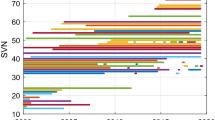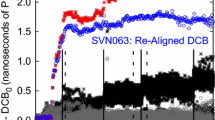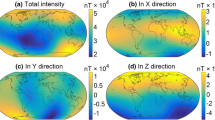Abstract
GPS Differential Code Biases (DCBs) computation is usually based on ground networks of permanent stations. The drawback of the classical methods is the need for the ionospheric delay so that any error in this quantity will map into the solution. Nowadays, many low-orbiting satellites are equipped with GPS receivers which are initially used for precise orbitography. Considering spacecrafts at an altitude above the ionosphere, the ionized contribution comes from the plasmasphere, which is less variable in time and space. Based on GPS data collected onboard JASON-2 spacecraft, we present a methodology which computes in the same adjustment the satellite and receiver DCBs in addition to the plasmaspheric vertical total electron content (VTEC) above the satellite, the average satellite bias being set to zero. Results show that GPS satellite DCB solutions are very close to those of the IGS analysis centers using ground measurements. However, the receiver DCB and VTEC are closely correlated, and their value remains sensitive to the choice of the plasmaspheric parametrization.









(credits: G. Zaouche, CNES)

(Sources: https://www.ngdc.noaa.gov for K p and F10.7 and http://wdc.kugi.kyoto-u.ac.jp for DST)
Similar content being viewed by others
References
AVISO website. http://www.aviso.altimetry.fr/fr/donnees/calval/orbit/precise-orbit-determination-verification.html
Banville S, Collins P, Zhang W, Langley RB (2013) Global and regional ionospheric corrections for faster PPP convergence. Navigation 61(2):115–124
Foelsche U, Kirchengast G (2002) A simple “geometric” mapping function for the hydrostatic delay at radio frequencies and assessment of its performance. Geophys Res Lett. doi:10.1029/2001gl012744
Gulyaeva TL, Huang X, Reinisch B (2002) Ionosphere-plasmasphere model software for ISO. Acta Geod Geophys Hung 37(2–3):143–152
Hernández-Pajares M, Juan JM, Sanz J, Orús R (2007) Second-order ionospheric term in GPS: implementation and impact on geodetic estimates. J Geophys Res. doi:10.1029/2006JB004707
Hernández-Pajares M, Juan JM, Sanz J, Orus R, Garcia-Rigo A, Feltens J, Komjathy A, Shaer SC, Krankowski A (2009) The IGS VTEC maps: a reliable source of ionospheric information since 1998. J Geod 83(3):263–275
Hofmann-Wellenhof B, Lichtenegger H, Collins J (2001) GPS theory and practice, 5, revised edn. Springer, Wien
Klobuchar JA (1996) Ionospheric effects on GPS. In: Parkinson BW, Spilker JJ (eds) Global positioning system: theory and applications, chapter 12, vol 1. American Institute of Aeronautics and Astronautics, New York, pp 485–515
Lee HB, Jee G, Kim YH, Shim JS (2013) Characteristics of global plasmaspheric TEC in comparison with the ionosphere simultaneously observed by Jason-1 satellite. J Geophys Res 118:935–946. doi:10.1002/jgra.50130
Lin J, Yue X, Zhao S (2016) Estimation and analysis of GPS satellite DCB based on LEO observations. GPS Solut 20(2):251–258
Liu L, Wan W, Ning B (2006) A study of the ionogram derived effective scale height around the ionospheric hmF2. Ann Geophys 24:851–860
Loyer S, Perosanz F, Mercier F, Capdeville H, Marty JC (2012) Zero-difference GPS ambiguity resolution at CNES–CLS IGS analysis center. J Geod 86(11):991–1003. doi:10.1007/s00190-012-0559-2
Marinov P, Kutiev I, Belehaki A, Tsagouri I (2015) Modeling the plasmasphere to topside ionosphere scale height ratio. J Space Weather Space Clim. doi:10.1051/swsc/2015028
Montenbruck O, Hauschild A, Steigenberger P (2014) Differential code bias estimation using multi-GNSS observations and global ionosphere maps. Navigation 61(3):191–201. doi:10.1002/navi.64
Wang N, Yuan Y, Li Z, Montenbruck O, Tan B (2015) Determination of differential code biases with multi-GNSS observations. J Geod 90(3):209–228
Xu G (2003) GPS theory, algorithms and applications. Springer, Berlin, Heidelberg, New York
Yizengaw E, Moldwin MB, Galvan D, Iijima BA, Komjathy A, Mannucci AJ (2008) Global plasmaspheric TEC and its relative contribution to GPS TEC. J Atmos Sol Terr Phys 70:1541–1548
Yue X, Schreiner WS, Hunt DC, Rocken C, Kuo YH (2011) Quantitative evaluation of the low earth orbit satellite based slant total electron content determination. Space Weather. doi:10.1029/2011SW000687
Zakharenkova I, Cherniak I (2016) How can GOCE and TerraSAR-X contribute to the topside ionosphere and plasmasphere research? Space Weather 13:271–285. doi:10.1002/2015SW001162
Zhong J, Lei J, Dou X, Yue X (2016) Is the long-term variation of the estimated GPS differential code biases associated with ionospheric variability? GPS Solut 20(3):313–319
Acknowledgements
The authors would like to acknowledge the International GNSS Service (IGS) for providing orbits and RINEX data of its high-quality network of permanent stations. They would also thank all colleagues from Centre National d’Etudes Spatiales (CNES) in Toulouse for the interesting discussions and advice while writing and revising this work. In particular, they thank Gérard Zaouche for providing hardware temperature data of GPSP-B instrument onboard JASON-2.
Author information
Authors and Affiliations
Corresponding author
Rights and permissions
About this article
Cite this article
Wautelet, G., Loyer, S., Mercier, F. et al. Computation of GPS P1–P2 Differential Code Biases with JASON-2. GPS Solut 21, 1619–1631 (2017). https://doi.org/10.1007/s10291-017-0638-1
Received:
Accepted:
Published:
Issue Date:
DOI: https://doi.org/10.1007/s10291-017-0638-1




